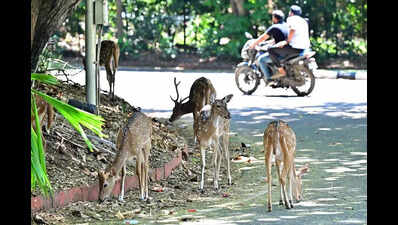Chennai: Guindy National Park (GNP) and the adjoining Raj Bhavan area recorded a slight rise in spotted deer and blackbuck population, according to the latest annual census conducted last month. Wildlife officials said the blackbuck population grew from 100 to 105, while the spotted deer numbers rose from 195 to 200. They attributed the improvement to recent habitat management efforts, including clearing wild growth across the four-hectare polo ground and removing the invasive antigonon leptopus creeper from 10hectares.
The spread of this creeper previously forced blackbucks, which prefer open grassland habitats, to retreat to the Raj Bhavan campus and other areas with suitable conditions. You Can Also Check: Chennai AQI | Weather in Chennai | Bank Holidays in Chennai | Public Holidays in Chennai The census was carried out using line transect and direct count methods, with Guindy National Park divided into blocks for systematic observation. Participants covered 20.

88km across 11 transect lines, recording sightings of the animals. The survey found that among blackbucks, 69% were adults, 24% sub-adults, and 7% fawns, with a male-to-female ratio of 1:0.4.
For spotted deer, 80% were adults, 15% sub-adults, and 5% fawns, with a male-to-female ratio of 2:2.2. While the increase this year offers some hope, experts have warned that the long-term trend remains a concern.
Census data from 1980 to 1992 showed a healthier ecosystem, with blackbuck numbers ranging between 150 and 175 and spotted deer to be around 250. Since then, blackbuck numbers have fallen steeply before 1992 and spotted deer numbers gradually dropping thereafter. The absence of large carnivores in the park should have typically supported stable or increasing herbivore populations .
Instead, factors such as habitat degradation, reduced natality, increased mortality, disease, and possible inbreeding likely contributed to the decline. Habitat changes, in particular, played a major role, with the proliferation of woody plants reducing the open landscapes and short grass cover that these species critically depend on for grazing..














